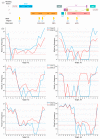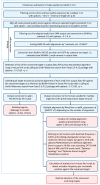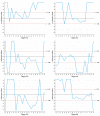A Bioinformatic Pipeline for Monitoring of the Mutational Stability of Viral Drug Targets with Deep-Sequencing Technology
- PMID: 29168754
- PMCID: PMC5744132
- DOI: 10.3390/v9120357
A Bioinformatic Pipeline for Monitoring of the Mutational Stability of Viral Drug Targets with Deep-Sequencing Technology
Abstract
The efficient development of antiviral drugs, including efficient antiviral small interfering RNAs (siRNAs), requires continuous monitoring of the strict correspondence between a drug and the related highly variable viral DNA/RNA target(s). Deep sequencing is able to provide an assessment of both the general target conservation and the frequency of particular mutations in the different target sites. The aim of this study was to develop a reliable bioinformatic pipeline for the analysis of millions of short, deep sequencing reads corresponding to selected highly variable viral sequences that are drug target(s). The suggested bioinformatic pipeline combines the available programs and the ad hoc scripts based on an original algorithm of the search for the conserved targets in the deep sequencing data. We also present the statistical criteria for the threshold of reliable mutation detection and for the assessment of variations between corresponding data sets. These criteria are robust against the possible sequencing errors in the reads. As an example, the bioinformatic pipeline is applied to the study of the conservation of RNA interference (RNAi) targets in human immunodeficiency virus 1 (HIV-1) subtype A. The developed pipeline is freely available to download at the website http://virmut.eimb.ru/. Brief comments and comparisons between VirMut and other pipelines are also presented.
Keywords: bioinformatic pipeline; data processing; deep-sequencing; drug targets; mutations; viruses.
Conflict of interest statement
The authors declare no conflict of interest.
Figures




Similar articles
-
[Mutation Frequencies in HIV-1 Genome in Regions Containing Efficient RNAi Targets As Calculated from Ultra-Deep Sequencing Data].Mol Biol (Mosk). 2018 May-Jun;52(3):460-465. doi: 10.7868/S0026898418030084. Mol Biol (Mosk). 2018. PMID: 29989577 Russian.
-
Analysis of Variability in HIV-1 Subtype A Strains in Russia Suggests a Combination of Deep Sequencing and Multitarget RNA Interference for Silencing of the Virus.AIDS Res Hum Retroviruses. 2017 Feb;33(2):194-201. doi: 10.1089/AID.2016.0088. Epub 2016 Aug 30. AIDS Res Hum Retroviruses. 2017. PMID: 27476852
-
Distinctive Drug-resistant Mutation Profiles and Interpretations of HIV-1 Proviral DNA Revealed by Deep Sequencing in Reverse Transcriptase.Biomed Environ Sci. 2016 Apr;29(4):239-47. doi: 10.3967/bes2016.031. Biomed Environ Sci. 2016. PMID: 27241734
-
Deep sequencing for HIV-1 clinical management.Virus Res. 2017 Jul 15;239:69-81. doi: 10.1016/j.virusres.2016.10.019. Epub 2016 Nov 3. Virus Res. 2017. PMID: 27818211 Review.
-
[Advance in Deep Sequencing of Small RNAs for Virus Identification and Discovery].Bing Du Xue Bao. 2015 Jul;31(4):457-62. Bing Du Xue Bao. 2015. PMID: 26524920 Review. Chinese.
References
MeSH terms
Substances
LinkOut - more resources
Full Text Sources
Other Literature Sources
Medical
Research Materials

